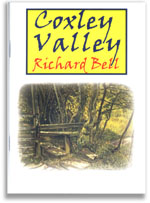 
Horse Chestnut Scale InsectFriday 19th May 2000 IT'S LAUNCH DAY at last for my booklet on Coxley Valley which I've been working over a period of months. It gets off to a good start with a signing session at Ossett Books. I've known the valley since visiting as a child, but I've been amazed how much history there is in the landscape; Domesday villages, medieval iron-working, the world's oldest railway tunnel, a Victorian pleasure gardens. I've also included a little about the wildlife, the wild flowers and the landscape.
Like aphids, the honeydew they excrete can lead to sooty moulds growing on leaves, leading to a reduction in tree growth. There is no practical cure. This species appeared in England in 1964 and was known in Europe before that date, but it isn't known in what part of the world it originated. My thanks to Sarah Bell for pointing out the insects and to Roger Gaynor for the identification. The information on the life cycle comes from an H.M.S.O. publication.
|